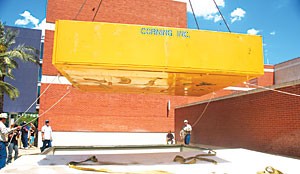Student workers are halfway through marking, taking inventory and mapping out the UA’s Arboretum, a collection of more than 7,000 trees on campus, giving each a uniquely numbered marking tag.
The marking program, which began in April, is used for inventory control, said Elizabeth Davison, director of the UA Arboretum.
“”The grounds keepers can call in and let us know that tree number 410 has been damaged or that they are pruning number 410 and we know exactly which tree they are talking about,”” Davison said.
Craig Wheeler, a plants sciences sophomore who is one of the students marking the trees, said the experience has helped him learn more about plants.
“”It works well for me because for my degree I need to know all the plants on campus anyway,”” Wheeler said.
Wheeler said he started working when the program first launched and has personally marked 1,000 trees on campus.
In addition to tracking trees, Davison said the tags help with construction planning because the trees that will be removed can be identified.
“”We can know right away what kind of trees those are, how easily they can be replaced and what dollar value they carry,”” Davison said.
The process is extensive, with students searching roughly 380 acres for 7,000 trees in 400 different species, sans the succulents, Davison said.
The tags also satisfy the curiosity of those who want to know about campus trees, Davison said.
“”I had someone just the other day call and ask what kind of tree was outside their dorm building,”” said Davison. “”By the tag number I was able to tell them right away.””
There is a public GIS map of the campus pinpointing the trees, and Davison said she eventually wants to add photos of every tree.
Trees on campus date back 120 years, according to the Arboretum’s Web site.
Most of the trees are from the Southwest and other arid and semi-arid climates from all over the world. Many of them are the oldest or only trees of their kind in the state, sometimes even the whole country, Davison said.
“”Tucson used to be a proving ground for new specimens of trees to the area,”” said Davison. “”If it did well, it would get adopted and used around town.””
Sean Park, a molecular and cellular biology senior who works in Herring Hall, the headquarters for the Arboretum, said he has watched it grow over his time at the UA.
“”It has been fun to see the progression; it definitely looks better now,”” said Park. “”It is important because it provides some different scenery than people are used to in Tucson.””
Davison said while it isn’t the intent of the Arboretum to boost enrollment at the UA, a more aesthetically pleasing campus can make students more comfortable and lead them to choosing one school over another.
“”It is a welcome relief,”” said Mike Costaglio, a mechanical engineering senior, of the trees. “”The fall is especially nice.””
During the remaining months of marking, the employees of the Arboretum have one request.
“”Don’t take the marking nails out of the trees,”” said Davison. “”The nails do not hurt the trees at all and it is counterproductive for us.””









